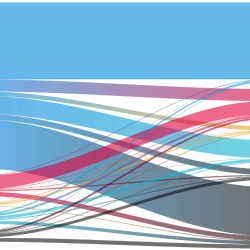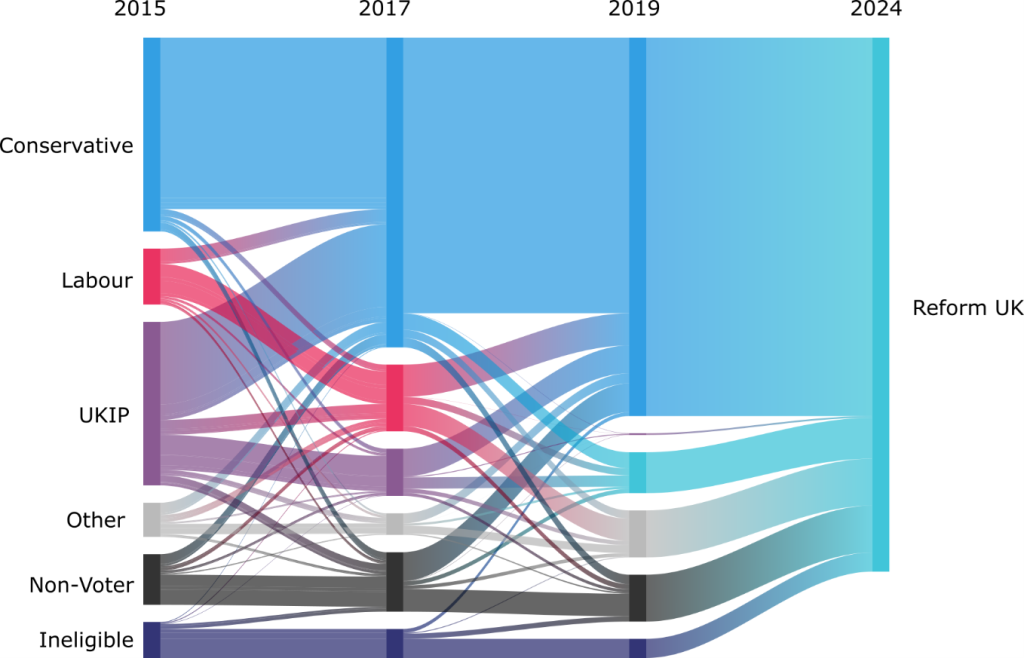James David Griffiths, Jane Green, Ed Fieldhouse
Using the recently released pre/post-election waves of the British Election Study Internet Panel, members of the team explore how we can use it to help us understand the 2024 UK General Election – now focusing on the performance of Reform UK.
We live in an era of reboots and sequels, where movies and TV shows of the past are frequently remade for a modern audience. In many ways, the 2024 UK General Election was a reboot of the 2015 election, as we saw a return to both high vote switching and low support for the two major parties. Contributing to these trends was another important parallel between 2015 and 2024– the performance of UKIP and Reform UK, respectively. Both parties were led by Nigel Farage, both parties mobilised anti-immigration sentiment, and both parties achieved the third largest vote share in each election (12.6 and 14.3 percent respectively) – with Reform winning five MPs compared to UKIP’s one.
Given the ongoing tensions surrounding immigration in Britain, it is important to examine the main party that mobilises this as a political issue – especially as the similarities between 2015 and 2024 mean that looking at the past may help us understand the present. Consequently, in this blog, we provide the first examination of Reform’s voters after the 2024 election.
Overall, the similarities between the two parties are not merely reflected in their leadership and performance – they also share many of the same voters. Using data from the recently released waves of the British Election Study Internet Panel, (Figure 1) we can see that many 2024 Reform UK voters backed UKIP in 2015 (31 percent). The overlap between the parties’ supporters is not perfect, as many 2024 Reform UK voters backed other parties in 2015 (mostly the Conservatives – 36 percent), but nonetheless it is considerable. These voters then moved behind the Conservatives in 2017 and 2019, which reflects the Conservatives’ monopolisation of pro-Brexit voters after the 2016 EU referendum, before they broke for Reform in 2024.
Figure 1: Support in 2015, 2017, and 2019 among 2024 Reform UK Voters
Data from BESIP Post-Election Wave, Weighted by Post-Election Weight. N: 3650. It is important to note that internet panel surveys are not the perfect instrument for capturing turnout, so the paths from non-voting should be interpreted with caution. Consequently, this figure is subject to renewal once we receive the results from the BES’s random probability face-to-face survey.
So, how did Reform UK manage to attract these voters away from the Conservatives? One explanation is the role of immigration, which is where there are clear echoes of 2015. Overall, 19 percent of the public felt that it was the most important issue facing Britain before the 2024 election (May 2024), but this rose to 69 percent among those who said that they were very likely to vote for Reform UK (Figure 2). Such salience gives radical right parties an advantage, as immigration is an issue where they are often seen as competent. Indeed, UKIP, the Brexit Party, and Reform UK were all seen as able to reduce immigration by those who were very likely to back them before each election between 2015 and 2024.
The key difference between 2015/2024 and 2017/2019 is the image of the Conservatives. In 2017 and 2019, many likely supporters of the radical right felt that the Conservatives could do something about immigration, which likely helped convince these people to back the Conservatives in both elections. In contrast, likely supporters of the radical right in 2015 and 2024 did not feel like the Conservatives could reduce immigration, and thus had no such motivation to back them over UKIP or Reform UK (respectively). Consequently, this combination of salience and party image may help explain why Reform managed to repeat (and build on) UKIP’s 2015 performance, when their 2017 and 2019 counterparts did not.
Figure 2: Most important issue and evaluations of whether the Conservatives and UKIP/Brexit/Reform would reduce immigration among pre-election UKIP, Brexit Party, and Reform UK supporters in 2015, 2017, 2019, and 2024
For the most important issue, people were asked to name the MOST important issue facing Britain. For immigration competence, people were asked whether any party would successfully reduce immigration from a list, where they could select multiple options. Pre-election support defined as people who said that they were “very likely” to vote for UKIP (2015, 2017), the Brexit Party (2019), and Reform UK (2024) on a scale from 0 (very unlikely) to 10 (very likely). Don’t knows are removed.
Another contributing factor was almost certainly the return of Nigel Farage, who announced that he would take over as leader from Richard Tice during the election campaign. At the time, there was much clamour that this would hurt the Conservatives, as Farage’s profile was considerably higher than that of Richard Tice (59 percent of Britain did not know who Tice was in May 2024, compared to 7 percent for Farage). It must be stated that many of those who strongly liked Nigel Farage were already going to vote for Reform UK before the election was announced (May 2024), but there is evidence that many of those who tended to like Farage (but were not going to vote for Reform) ended up voting for them in 2024 after his return (Figure 3) – with the bulk (52 percent) being people who had said that they would either not vote or didn’t know who they would vote for before the campaign started. Thus, while we cannot be definitive about the impact of Nigel Farage, these results suggest that his return did manage to convince some undecided voters to back Reform.
Figure 3: Vote in the 2024 UK General Election by Assessment of Nigel Farage in May 2024
I use pre-election assessment of Nigel Farage (May 2024) and post-election vote. I retain those who said that they would not vote or don’t know in May 2024 to capture any potential conversion of undecided voters, but exclude them from the post-election wave so that I focus only on those who cast a ballot. (Reform in both: N 1,696; Switched to Reform: N 1,260)
Ultimately, Reform UK’s performance in 2024 appears like a reboot of UKIP in 2015 because many of the fundamentals were similar in both elections – the salience of immigration, the perceived weakness of the Conservatives on that issue, and the presence of Nigel Farage. These trends are crucial for understanding the performance of the radical right in British elections, particularly as Reform UK now have a larger foothold in British politics than UKIP did in 2015.
That said, we should not assume that this version of the story will have the same outcome for Reform as it did for UKIP in 2015, as there are some key differences. First, 2015 was fought in a context where UKIP were actively campaigning to exit the EU, which the Conservatives latter adopted as their core platform. Now that Britain has left the EU, and Brexit is far less immediately salient, then the Conservatives lack a unifying issue that they can use to convince radical right voters to back them – as they did in 2017 and 2019. On the other hand, the Conservatives were far less popular in 2024 than they were in 2015, and this unpopularity – combined with the seeming inevitability of Labour’s victory – may have encouraged some voters to back Reform over the Conservatives because they felt that doing so was not going to change the result (a sentiment that Nigel Farage promoted actively ). As a result, only time will tell if Reform can hold onto these voters when the electoral context is different, and the Conservatives are less unpopular.




